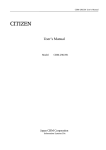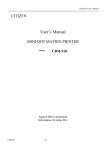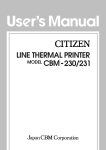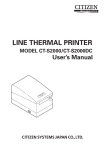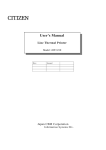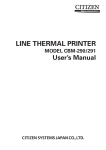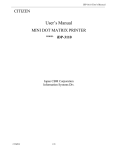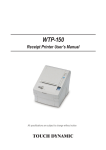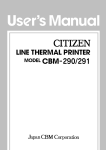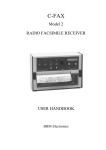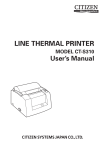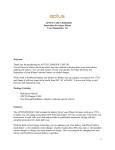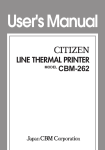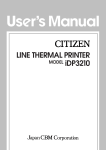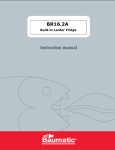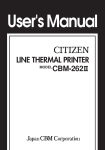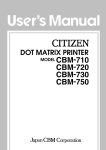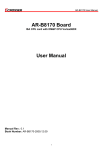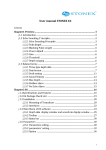Download User`s Manual LINE THERMAL PRINTER CBM-230/231
Transcript
User’s Manual
LINE THERMAL PRINTER
MODEL
CBM-230/231
Japan CBM Corporation
Information Systems Div.
CBM-230/231 User’s Manual
1996.08.02(10-DCL)15
Declaration of Conformity
Manufacturer's Name :
: Japan CBM Corporation
Manufacturer's Address
: 1-1-7, Okubo, Shinjuku-ku, Tokyo
169, Japan
Declare the Product
Product Name
Thermal Printer
Model Number (s)
CBM230 Series
(CBM230R,CBM230P,CBM231R, BM231P
(S.NO.95Y0001 -
)
Conform to the following Standards
LVD
: EN60950
:1992+A1+A2:1993
EMC
: EN55022
:1994 Class A
: EN61000-3-2
: EN50082-1
: IEC801-2
: IEC801-3
: IEC801-4
:1995
:1992
:1991 4KV CD, 8KV AD
:1984 3V/m, 27MHz-500MHz
:1988 0.5KV Signal Line 1KV AC mains
Supplementary Information
"The product complies with the requirements of the Low Voltage Directive 73/23/EEC,
93/68/EEC and the EMC Directive 89/336EEC, 92/31/EEC, 93/68EEC"
Signature
Place
Tokyo, Japan
Date
November, 1995
Full Name : Koji Tanabe
Position : General Manager
R & D Department
Europe Contact :
Europe Liaison Office
Kuruisweg 805, Holland Office Center Building
3-2132 NG Hoofddorp, the Netherlands
Warning
This is a Class A products. In a domestic environment this product may cause radio interference
in which case the user may be required to take adequate measures.
This declaration is applied only for 230V model.
CITIZEN
2
CBM-230/231 User’s Manual
IMPORTANT SAFETY INSTERUCTIONS
Read all of these instructions and save them for later reference.
Follow all warnings and instructions marked on the product.
Unplug this product from the wall outlet before cleaning. Do not use liquid or aerosol cleaners. Use a damp
cloth for cleaning.
l Do not use this product near water.
l Do not place this product on an unstable cart, stand of table. The product may fall, causing serious damage
to the product.
l Slots and openings on the cabinet and the back or bottom are provided for ventilation.
To ensure reliable operation of the product and to protect it form overheating, do not block or cover these
openings. The openings should never be blocked by placing the product on a bed, sofa, rug of other similar
surface.
This product should never be placed near or over a radiator or heat register.
This product should not be placed in a built-in installation unless proper ventilation is provided.
l This product should be operated from the type of power source indicated on the marking label.
If you’re not sure of the type of power available, consult your dealer or local power company.
l Do not allow anything to rest on the power cord. Do not locate this product where the cord will be walked
on.
l In an extension cord is used with this product, make sure that the total of the ampere ratings on the products
plugged into the extension cord do not exceed the extension cord ampere rating.
Also, make sure that the total of all products plugged into the wall outlet dose not exceed 15 amperes.
l Never push objects of any kind into this product through cabinet slots as they may touch dangerous voltage
points or short out parts that could result in a risk of fire or electric shock. Never spill liquid of any kind on
the product.
l Except as explained elsewhere in this manual, don’t attempt to service this product yourself.
Opening and removing those covers that are marked “Do Not Remove” may expose you to dangerous
voltage points or other risks. Refer all servicing on those compartments to service personnel.
l Unplug this product from the wall outlet and refer servicing to qualified service personnel under the
following conditions:
A. When the power cord or plug is damaged or frayed
B. If liquid has been spilled into the product.
C. If the product has been exposed to rain or water.
D. If the product dose not operate normally when the operating instructions are followed. Adjust only those
controls that are covered by the operating instructions since improper adjustment of other controls may
result in damage and will often require extensive work by a qualified technician to restore the product to
normal operation.
E. If the product has been dropped the cabinet has been damaged.
F. If the product exhibits a distinct change in performance, indicating a need for service.
l
l
l
CITIZEN
3
CBM-230/231 User’s Manual
IMPORTANT: This equipment generates, uses, and can radiate radio frequency energy and if not installed and used in
accordance with the instruction manual, may cause interference to radio communications. It has been tested and found to
comply with the limits for a Class A computing device pursuant to Subpart J of Part 15 of FCC Rules, which are designed
to provide reasonable protection against such interference when operated in a commercial environment. Operation of this
equipment in a residential area is likely to cause interference, in which case the user at his own expense will be required to
take whatever measures may be necessary to correct the interference.
CAUTION: Use shielded cable for this equipment.
For Uses in Canada
This digital apparatus does not exceed the class A limits for radio noise emissions from digital, apparatus, as set out in the
radio interface regulations of the Canadian department of communications.
CITIZEN
4
CBM-230/231 User’s Manual
CONTENTS
1 GENERAL DESCRIPTION ..............................................................................................................................................6
1.1 Features ....................................................................................................................................................... 6
1.2 Precautions for Installation ........................................................................................................................... 6
2 BASIC SPECIFICATIONS ...............................................................................................................................................7
2.1 Model Classification ..................................................................................................................................... 7
2.2 Specifications List ........................................................................................................................................ 8
2.3 Specifications for Printing Paper ................................................................................................................... 9
2.3.1 Specified Paper ...................................................................................................................................... 9
2.3.2 Printing Position .................................................................................................................................. 9
2.3.3 Head and Cutter Positional Relations.................................................................................................... 9
3 APPEARANCE AND COMPONENT PARTS...............................................................................................................10
4 OPERATION...................................................................................................................................................................11
4.1 Connecting the Interface Cable.................................................................................................................... 11
4.2 Connecting the Drawer Kick Connector....................................................................................................... 12
4.3 Inserting the Paper Roll .............................................................................................................................. 13
4.4 Operation Panel .......................................................................................................................................... 17
4.5 Opening the Auto Cutter(CBM-231) ........................................................................................................... 18
5 SETTING OF DIP SWITCHES.......................................................................................................................................19
6 PARALLEL INTERFACE...............................................................................................................................................22
6.1Specifications .............................................................................................................................................. 22
6.2 Connector's Pin Configuration..................................................................................................................... 22
6.3 Input / Output Signals................................................................................................................................. 23
6.3.1 Input / Output Signals.......................................................................................................................... 23
6.3.2 Electrical Characteristics...................................................................................................................... 24
6.3.3 Timing Chart ....................................................................................................................................... 25
6.3.4 Data Receiving Control........................................................................................................................ 25
6.3.5 Buffering ............................................................................................................................................. 25
7 SERIAL INTERFACE.....................................................................................................................................................26
7.1 Specifications ............................................................................................................................................. 26
7.2 Connector's Pin Configuration..................................................................................................................... 27
7.3 Input / Output Signals................................................................................................................................. 28
7.3.1 Input / Output Signals.......................................................................................................................... 28
7.3.2 Data Configuration .............................................................................................................................. 29
7.3.3 Error Detection .................................................................................................................................... 29
7.3.4 Data Receiving Control........................................................................................................................ 30
7.3.5 Buffering ............................................................................................................................................. 30
7.3.6 Electrical Characteristics...................................................................................................................... 31
8 DRAWER KICK CONNECTOR....................................................................................................................................32
8.1 Specifications ............................................................................................................................................. 32
8.2 Connector's Pin Configuration..................................................................................................................... 32
8.3 Drive Circuit ............................................................................................................................................ 32
9 PRINT CONTROL FUNCTION .....................................................................................................................................33
9.1Control Codes List....................................................................................................................................... 33
9.2Input Data Format ....................................................................................................................................... 34
10 CHARACTER CODE TABLE......................................................................................................................................54
10.1International .............................................................................................................................................. 54
10.2 International Character Code Table........................................................................................................... 55
Appendix 1. Precaution and Maintenance ...........................................................................................................................56
Appendix 2. External Dimensions .......................................................................................................................................57
Appendix 3. Block Diagram................................................................................................................................................59
CITIZEN
5
CBM-230/231 User’s Manual
1 GENERAL DESCRIPTION
This is a small line thermal printer developed to be used for various data communication terminals such as POS
terminals, kitchen printers.
With its abundant features, it can be widely used for various types of applications.
Read this manual thoroughly prior to using the printer to understand its contents.
1.1 Features
1. Compact, light-weight, and small installation area required
2. High speed and low noise due to line thermal printing
3. High reliability due to long-life printing head and simple mechanism
4. Input buffer incorporated
5. Capable of printing a bar codes (exclusive command)
6. Drawer kickout interface incorporated
7. Equipped with an auto cutter (CBM-231)
8. User-Defined character registration function(95 characters)
9. Easy handling due to incorporated power supply
1.2 Precautions for Installation
1. Upon unpacking the printer, make sure that the following parts are contained in
the package.
Printer main body
1 unit
Sample paper roll
1 roll
Instruction manual
1 copy
2. Install the printer on a flat and stable desk or table.
3. Do not install the printer near a heater or in the direct sunshine.
4. Do not use the printer in a high-temperature, high-humidity, or contaminated environment.
5. Prepare a separate AC power supply from other equipment which causes noises.
6. Connect only a specified solenoid to the drawer kick connector.
7. When transporting or not using the printer for a long period of time, leave the printing head kept up.
CITIZEN
6
CBM-230/231 User’s Manual
2 BASIC SPECIFICATIONS
2.1 Model Classification
The model is classified by the following designation method.
CBM-230
--
R
Model
CBM-230 : Standard model
CBM-231 : Auto cutter incorporated
F
120
AC power source
120 : AC120V(60Hz)
230 : AC230V(50/60Hz)
Character set
F : International use
Interface
R : Serial (RS-232C)
P : Parallel (Conforms to CENTRONICS)
CITIZEN
7
CBM-230/231 User’s Manual
2.2 Specifications List
Item
Printing system
Print width
Dot density
Printing speed
No. of columns
Character size
Character type
Bar code type
Line pitch
Paper
Interface
Input buffer
Power supply voltage
Power consumption
Weight
External dimensions (main body)
Operating temperature/humidity
Storage temperature/humidity
Reliability
Description
Line thermal dot printing system
72 mm/576 dots
8 dots / mm (Horizontal, Vertical)
62.5 mm/sec. (at Max. speed) (500-dot Line / sec.)
48 columns (12 x 24, Font A) *(42 columns)
64 columns ( 9 x 17, Font B)
*(56 columns)
1.25 mm x 3.00 mm (12 x 24, Font A)
0.88 mm x 2.13 mm ( 9 x 17, Font B)
Alphanumeric, International characters
UPC-A/E, JAN(EAN) 13 columns/18 columns, ITF
CODE 39, CODE 128, CODABAR
1/6 inch (approx. 4.23mm) (can be selected by Command)
Min. 1/203 inch
Thermal roll paper 80 mm x Ø83 mm
(Refer to Specifications for Print Paper)
Serial (RS-232C), Parallel (Conforms to Centronics.)
72 byte / 4 K byte (Can be selected with the Dip switch)
120 V AC ± 10 %, 60 Hz
230 V AC ± 10 %, 50 / 60 Hz
100W
1.70 kg (CBM-230), 1.85 kg (CBM-231)
145 (W) x 216 (D) x 150 (H)
5 - 40 °C
-20 - 60 °C
Print head’s life :
Pulse resistance 50 million pulses
Wear resistance 30 Km
(Printing ratio 12.5%, normal temperature,
normal humidity, recommended paper)
Auto cutter’s life :
300,000 cut (Normal temperature,
normal humidity, recommended paper)
* Special ROM only
CITIZEN
8
CBM-230/231 User’s Manual
2.3 Specifications for Printing Paper
2.3.1 Specified Paper
Type
: Thermal paper
Paper width
: 80+0 or -1 mm
Paper thickness
: 65 ± 5 Micro m
Roll diameter
: Ø83mm or less
Print surface
: Outside of the roll(surface)
Recommended paper : TF50KS-E2C made by Nihon Paper Mill. or other equivalent
Core
: Ø12 mm (inner diameter), Ø18 mm (outer diameter)
[Caution] Do not paste the paper to the core.
2.3.2 Printing Position
2.3.3 Head and Cutter Positional Relations
CITIZEN
9
CBM-230/231 User’s Manual
3 APPEARANCE AND COMPONENT PARTS
CITIZEN
10
CBM-230/231 User’s Manual
4 OPERATION
4.1 Connecting the Interface Cable
1. Turn off the power.
2. Confirm the vertical direction of a cable terminal and connect it to the interface connector.
3. Fix the cable terminal.
Serial interface
: Tighten screws to fix.
Parallel interface
: Turn a fixture in an arrow direction to fix.
4. Connect the cable to the computer.
CITIZEN
11
CBM-230/231 User’s Manual
4.2 Connecting the Drawer Kick Connector
1. Turn off the power.
2. Confirm the vertical direction of a drawer kick cable connector and insert
it into the drawer kick connector on the back of the printer.
3. Using a screw, fix a drawer's earthing conductor to the earth terminal of the printer.
[Caution] Connect only a specified drawer(solenoid) to the drawer kick connector.
CITIZEN
12
CBM-230/231 User’s Manual
4.3 Inserting the Paper Roll
[Caution] Be sure to use a specified paper roll.
1. Open the printer cover.
2. Shift the head-up lever in an arrow direction to move up the printing head.
[Caution] When setting the paper roll, you do not have to open the auto cutter. (CBM-231)
CBM-231
CITIZEN
13
CBM-230/231 User’s Manual
3. Using the scissors, cut the end of the paper at a right angle.
[Caution] Do not insert the paper with its end fluffed or bent.
4. Confirm the winding direction of the paper roll. Opening the paper holder in the direction of the arrow,
set the paper and hold the core center properly.
[Caution] Make sure that the paper roll rotates smoothly without tilting the paper.
CITIZEN
14
CBM-230/231 User’s Manual
5. Insert the end of the paper into the paper inlet, turn the paper feed knob in the direction of the arrow
to feed out the paper about 5 cm from the paper outlet of the auto cutter or nose of the manual cutter.
(The figure below shows the CBM-231).
[Caution] Do not turn the paper feed knob when the printing head is in its down position.
6. When the paper is tilting, correct it and move the printing head down.
CITIZEN
15
CBM-230/231 User’s Manual
7. Cut off the surplus paper at the edge of the paper outlet of the auto cutter or
blade of the manual cutter.
8. Close the printer cover. You are finished with setting of the paper roll.
[Caution] Do not open the printer cover during printing.
9. When removing the remaining paper upon its replacement with new one, pull it out
straight with the printing head kept up.
10. When using the auto loading function, follow the procedure below.
(1) Change the setting of the DIP switch to the auto loading mode. (Turn on DS1-3)
(2) Move the printing head up.
(3) Insert the end of the paper straight into the paper inlet of the printer and move down the printing
head. The paper is automatically pulled in by a constant amount.
(4) Close the printer cover to finish setting of the paper roll.
[Caution] When the paper is tilting, move up the printing head and correct it manually.
CITIZEN
16
CBM-230/231 User’s Manual
4.4 Operation Panel
1. POWER LED(green)
Illuminated when the power is supplied.
2. ERROR LED(red)
Indicates different errors, depending on the illuminated or blinking condition.
ERROR DETAIL
DISPLAY PATTERN
RESETTING METHOD
Printer cover open
Illuminated
Close the cover
Head Up
Illuminated
Move down the head
Memory check
Disabled
Head overheat
Automatically reset by
temperature drop
Macro execution wait
Press the LF switch
Cutter motor lock
Eliminate paper jam
and press LF switch
3 PAPER LED(red)
Near end enabled
: Illuminated when the paper is near its end (Stops after printing the set length)
Near end disabled
: Illuminated when the paper is at its end (Stops printing)
[Caution] Use the DIP switch to enable or disable the near end detecting function.
4 LF switch
Pressing this switch for a short time feeds the paper by one line. Holding it down feeds the paper continuously.
In case of macro execution wait, pressing the LF switch executes it.
[Caution] Depending on a selection of the DIP switch, the paper can be fed when the cover is opened.
CITIZEN
17
CBM-230/231 User’s Manual
5 LF switch and power switch
Self-printing is performed by turning on the power switch with the LF switch held down.
4.5 Opening the Auto Cutter(CBM-231)
When the paper is jamming or when you open the auto cutter in order to clean the head, raise the auto cutter,
pulling the cutter lock lever in the direction of the arrow.
[Caution] Immediately after printing, the printing head and motor have a high temperature.
Never touch the printing head and motor when you open the auto cutter.
CITIZEN
18
CBM-230/231 User’s Manual
5 SETTING OF DIP SWITCHES
The DIP switches are located in the position shown in the figure below. Unscrew and remove the DIP switch cover.
[Caution] Turn off the power to set the DIP switch.
CITIZEN
19
CBM-230/231 User’s Manual
DS1
-1
-2
-3
-4
-5
-6
-7
-8
FUNCTION
Paper cutter
Cover open
Auto loading
Input buffer
Paper near end
Paper near end remainder 1
Paper near end remainder 2
CR switching
DS2
LF activated
FUNCTION
Print density
Print density
International character
Unused
International character
International character
International character
International character
-1
-2
-3
-4
-5
-6
-7
-8
DS3
-1
-2
-3
-4
ON
OFF
Equipped
Not Equipped
Disabled
Enabled
Enabled
Disabled
72 bytes
4K bytes
Disabled
Enabled
Refer to the table below
ON
OFF
Refer to the table below
International
Refer to the table below
ON
7 bits
Equipped
Even
XON-XOFF
Bit length
Parity
Odd / even
DTR / XON-XOFF
Ignored
OFF
8 bits
Not equipped
Odd
DTR / DSR
DS4
ON
OFF
-1
Baud rate
Refer to the table below
-2
Baud rate
-3
Baud rate
-4
Unused
The Switch segment marked * are set depending on each models.
The DIP switches DS3 and DS4 are only for the serial interface.
Remaining printable Length
DS1-6
7
Print density
DS-1
-2
CITIZEN
Light
OFF
OFF
0 cm
OFF
OFF
50 cm
ON
OFF
Standard
ON
OFF
1m
OFF
ON
2m
ON
ON
Dark
OFF
ON
20
darker
ON
ON
FACTORY SETTING
*
OFF
OFF
OFF
OFF
OFF
OFF
OFF
FACTORY SETTING
ON
OFF
OFF
OFF
OFF
OFF
OFF
OFF
FACTORY SETTING
OFF
OFF
OFF
OFF
FACTORY SETTING
OFF
ON
ON
OFF
CBM-230/231 User’s Manual
SPAIN
OFF
OFF
ON
OFF
ON
OFF
ON
OFF
OFF
ON
ON
OFF
ON
ON
ON
OFF
300
ON
OFF
OFF
600
OFF
ON
OFF
1200
ON
ON
OFF
21
2400
OFF
OFF
ON
4800
ON
OFF
ON
OFF
OFF
OFF
ON
DENMARK2
ITALY
ON
ON
OFF
OFF
NORWAY
SWEDEN
OFF
ON
OFF
OFF
JAPN
DENMARK 1
150
OFF
OFF
OFF
ON
OFF
OFF
OFF
U.K.
OFF
OFF
OFF
OFF
GERMANY
CITIZEN
FRANCE
BAUD RATE
DS4-1
-2
-3
U.S.A.
INTERNATIONAL
DS1-6
DS1-6
-7
-8
OFF
OFF
ON
ON
OFF
ON
OFF
ON
9600
OFF
ON
ON
19200
ON
ON
ON
CBM-230/231 User’s Manual
6 PARALLEL INTERFACE
6.1Specifications
Data input method
Control signal
Applicable connectors
: 8-bit parallel(DATA 1-8)
: ACK, BUSY, STB, FAULT, PE, RESET
: Printer side : 57LE-40360(equivalent to amphenol)
Cable side : 57-30360(equivalent to amphenol)
6.2 Connector's Pin Configuration
No.
1
2
3
4
5
6
7
CITIZEN
SIGNAL NAME
STB
DATA 1
DATA 2
DATA 3
DATA 4
DATA 5
DATA 6
No.
19
20
21
22
23
24
25
22
SIGNAL NAME
TWISTED PAIR GND
|
|
|
|
|
|
CBM-230/231 User’s Manual
6.3 Input / Output Signals
6.3.1 Input / Output Signals
(1) Input signals to the printer
l DATA
: This is an 8-bit parallel signal (Positive logic)
l STB
: This is a strobe signal to read in 8-bit data (Negative logic)
l RESET
: This signal resets the entire printer (Negative logic) 1 ms or more
(2) Output signals from the printer
l ACK
: This is an 8-bit data request signal. Pulse signal output at the end of
the BUSY signal (Negative logic)
l BUSY
: This signal indicates the BUSY state of the printer. Enter new data when it is
at LOW. (Positive logic)
l FAULT
: This signal is set to low when the printer has an alarm.
When this is done, all control circuits in the printer stop. (Negative logic)
l PE
: This signal is output when the printing paper has run out or is running out.
(Positive logic)
l Drawer switch output : This signal is set to HIGH when the switch is opened, and to LOW when shorted.
(3) Power signals
l +5VDC : This is a 5 V output pulled up at a 3.3 k Ohm resistor.
l GND
: This is a common ground on the circuits.
CITIZEN
23
CBM-230/231 User’s Manual
6.3.2 Electrical Characteristics
(1) Input signal level
All input signals are at the TTL level.
"HIGH" level: 2.0 V at minimum
"LOW" level : 0.8 V at maximum
(2) Output signal level
All output signals are at the TTL level.
"HIGH" level: 2.4 V at minimum
"LOW" level : 0.4 V at maximum
(3) Input/output conditions
All input signals are pulled up at 3.3 k Ohm.
All output signals are pulled up at 3.3 k Ohm.
CITIZEN
24
CBM-230/231 User’s Manual
6.3.3 Timing Chart
(1) Data input and printing timing
T1, T2, T3
T4
T5
T6
0.5µs MIN
270 ns MAX
2.3 µs TYP
500 ms MIN (at power-on)
6.3.4 Data Receiving Control
When the BUSY signal is at LOW, the data from the host side can be received, but when at HIGH, it cannot
be received.
6.3.5 Buffering
A size of the input buffer can be selected by setting the DIP switch segment DS1-4.
When a 4KB buffer is selected, the host side is immediately free because a large amount of data can
be buffered.
CITIZEN
25
CBM-230/231 User’s Manual
7 SERIAL INTERFACE
7.1 Specifications
(1) Synchronizing system : Asynchronous
(2) Baud rate : 150, 300, 600, 1,200, 2,400, 4,800, 9,600, 19,200 bps (Selected by the user)
(3) Word Length
Start bit
Data bit
Parity bit
Stop bit
: 1 bit
: 7 bits or 8 bits (Selected by the user)
: Odd/even parity or no parity (Selected by the user)
: 1 bit or more
(4) Signal polarity
RS-232C
l Mark = Logic "1" (-3 V to -12 V)
l Space = Logic "0" (+3 V to +12 V)
(5) Receive data (RD signal)
RS-232C
l Mark = 1
l Space = 0
(6) Data receiving control (DTR signal)
RS-232C
l Mark : Data transfer not possible
l Space : Data transfer possible
(7) Data transmission control (TD signal)
DC1 code(11H) X-ON
: Data reception possible
DC3 code(13H) X-OFF
: Data reception not possible
CITIZEN
26
CBM-230/231 User’s Manual
7.2 Connector's Pin Configuration
No.
1
7
3
20
2
6
[Cautions]
SIGNAL NAME
FG
GND
RD
DTR
TD
DSR
I/O
Input
Output
Output
Input
1. RS-232C signals are based on the EIA RS-232C.
2. When no data is being transferred, the receive data should be always maintained in the mark
state.
Applicable connectors (D-Sub connectors)
Printer side : 17LE-13250 (Equivalent to DDK)
Cable side : 17JE-23250 (Equivalent to DDK)
CITIZEN
FUNCTION
Frame Grand
Signal GND
Receiving data
Printer BUSY signal
Transmission data
Data set READY
27
CBM-230/231 User’s Manual
7.3 Input / Output Signals
7.3.1 Input / Output Signals
(1) RD
This is a serial receive data signal. When there is a framing error, overrun error, or parity error,
that data is printed as "?."
(2) DTR
Write the data or a command when this signal is ready.
If you write while it is busy, the data will be ignored, resulting in an overrun error.
The data can be written into the input buffer even during printing.
A BUSY signal is also issued at power-on, during test printing, in the on-line mode, or upon occurrence
of reset.
(3) TD
When the remaining capacity of the input buffer on the printer side comes to 10 bytes(at 72 bytes) or
128 bytes(at 4K bytes) while receiving the data, DC3(13H), a data reception impossible signal, is output.
When the remaining capacity of the input buffer comes to over 20 bytes(at 72 bytes) or
256 bytes(at 4K bytes)DC1(11H), a data reception
possible signal is output to the host side.
When transmitting the status information, if DTR/DSR control has been selected, the data will be
transmitted after confirming that DSR is a space.
If DTR/DSR control has not been selected, the data will be transmitted, ignoring DSR.
(4) FG
This is a Frame ground.
(5) GND
This is a common ground on the circuits.
CITIZEN
28
CBM-230/231 User’s Manual
7.3.2 Data Configuration
1
2
3
1 Start bit
2 Data bit(+ parity bit)
3 Stop bit(1 or more)
(1) Start bit
When half a bit has passed since a fall edge of a mark to a space, the state of the bit is read in again,
and if it is a space, it will be recognized as a start bit.
If it is a mark, it will not be recognized as the start bit. The start bit will be detected again without
assuming it to be an error.
(2) Data bit + parity bit
The data bit and parity bit are sampled for one bit worth of time since the time of half the start bit
and assume the then state to be the data for the relevant bits.
The bits are arranged in order of bit 0, bit 1, ...., parity bit, starting from the one next to the start bit.
(3) Stop bit
The stop bit is a 1-bit or more mark level. If a space is detected in detecting the stop bit, a framing error
will result.
7.3.3 Error Detection
A parity error, framing error, and overrun error are detected. When an error is detected, that data is stored
in the buffer as "?."
(1) Framing error
When a space is detected at stop bit detection time, an error result. That data is stored in the buffer as "?."
(2) Parity error
When a parity check has been specified and an error is detected at parity check time,
that data is stored in the buffer as "?."
(3) Overrun error
When an overrun error is detected, that data is stored in the buffer as "?."
CITIZEN
29
CBM-230/231 User’s Manual
7.3.4 Data Receiving Control
When DTR/DSR control has been selected, if the DTR signal is at SPACE, the data from the host side can be
received, but when at MARK, it cannot be received.
When DTR/DSR control has not been selected, the data from the host side can be received after transmitting
XON, but it cannot be received after transmitting XOFF.
7.3.5 Buffering
There are DTR and TD signals as control signals for data transfer to the input buffer.
(1) DTR signal (Refer to 7.3 1)
(2) TD signal (Refer to 7.3 1)
CITIZEN
30
CBM-230/231 User’s Manual
7.3.6 Electrical Characteristics
(1) RS-232C circuit
Input (RD,DSR)
Output (DTR,TD)
CITIZEN
31
CBM-230/231 User’s Manual
8 DRAWER KICK CONNECTOR
8.1 Specifications
(1) Drawer kick drive signal
The pulses specified by ESC p are output. The state of the switch(+) can be known through the pin 34
of the interface connector when parallel interface is used, and through the ESC u command
when the serial interface is used.
(2) Electrical characteristics
1) Drive voltage
: DC 24 V
2) Drive current
: 0.8 A at maximum(should be within 510 ms)
3) Switch signal
: Signal level
"L" = 0 to 0.5 V
"H" = 3 to 5 V
8.2 Connector's Pin Configuration
No.
1
2
3
4
5
6
SIGNAL NAME
FG
DRAWER 1
DRSW
VDR
DRAWER 2
GND
Connector used
Applicable connector
FUNCTION
Frame ground
Drawer 1 driving signal
Drawer SW input
Drawer driving power supply
Drawer 2 driving signal
Common ground on the circuits
: TM5RJ3-66(HIROSE)
:Equivalent to TM3P-66P(HIROSE)
[Cautions] 1) No output is allowed during printing.
2) The drawers 1 and 2 cannot be driven at the same time.
3) A solenoid for the drawer should be of 36 Ohm or more.
(See to it that an output current will not exceed 0.8 A.
Be careful not to use a drawer with a current over 0.8A to avoid damage to the printer.)
8.3 Drive Circuit
CITIZEN
32
CBM-230/231 User’s Manual
9 PRINT CONTROL FUNCTION
9.1Control Codes List
1
2
3
4
5
6
7
8
9
10
11
12
13
14
15
16
17
18
19
20
21
22
23
24
25
26
27
28
29
30
31
32
33
34
35
36
37
38
39
40
41
42
CITIZEN
CONTROL CODE
HT
CR
LF
ESC SP
!
%
&
*
2
3
@
D
E
G
J
R
c3
c4
c5
d
p
t
v
u
{
V
$
¥
GS k
w
h
H
f
*
/
:
^
ESC =
a
i
m
FUNCTION
Horizontal tab command
Print command
Printing and paper feed
Setting the right space amount of the character
Collective specifying printing mode
Specifying/canceling download character set
Defining download characters
Specifying the bit image mode
Specifying/canceling underline
Specifying 1/6-inch line feed rate
Setting line feed rate n/203 inch
Initializing the Printer
Setting horizontal tab position
Specifying/canceling highlighting
Specifying/canceling double printing
Printing and feeds paper n/203 inch
Selecting the international characters
Setting of paper end sensor effective for outputting a signal for no
paper(Parallel Mode Only)
Setting of paper end sensor effective for print stop
Enabling/disabling the panel switches
Printing and feeding the paper by n lines
Generating the specified pulse(Drawer Kickout)
Selecting the character code table
Transmitting the printer status(Serial Mode Only)
Transmitting the status of peripheral equipment(Serial Mode Only)
Specifying/canceling the inverted characters
Specifying/canceling the 90°- right-turned characters
Specifying the absolute positions
Specifying the relative positions
Printing the bar code
Selecting the horizontal size (scale factor) of bar code
Selecting the height of the bar code
Selecting the printing position of HRI character
Selecting the font of HRI character
Defining the download bit image
Printing the download bit image
Starting/ending macro definition
Executing the macro
Data input control
Aligning the characters
Full cut
Partial cut
33
CBM-230/231 User’s Manual
9.2Input Data Format
(1) Horizontal Tab Command (HT)
Code : (09)h
Shifts the printing position to the next horizontal tab position. The horizontal tab position is set
by ESC D. Initial setting of the horizontal tab position is in 9th, 17th, 25th, 33rd, 41st columns of
FONT A.
(2) Print Command (CR)
Code : [0D]h
1) When DS 1 - 8 is OFF:
This command is ignored.
2) When DS 1- 8 is ON:
With data held inside the input buffer, printing and line feed are performed.
Without data inside the input buffer, however, no printing is performed.
(3) Printing and Paper Feed Command (LF)
Code : [0A]h
Prints data inside the internal input buffer and feeds lines based on the line feed
amount having been set.
(4) Setting the right space amount of the characters (ESC SP)
Code : [1Bh] + [20h] + n
* {0 < n < 20} Data is described in Hex code.
The rightward space amount is set in dot unit (0.165 mm unit). In the initial value, it is n=0.
The rightward space amount in double wide mode is made double of the set volume.
CITIZEN
34
CBM-230/231 User’s Manual
(5) Specifying Collectively the Print Mode (ESC ! n)
Code: [1Bh] + [21h] + n
* {0 < n < FF} The data is described in Hex code.
Printing mode is assigned. Each n bit indicates the following:
BIT
FUNCTION
VALUE
0
Font A
1
0
Character font
Font B
1
Undefined
2
Undefined
3
Highlighting
Canceled
Specified
4
Double height
Canceled
Specified
5
Double width
Canceled
Specified
6
Undefined
7
Underline
Canceled
Specified
l With double height and double width being specified simultaneously, double wide and
double high characters are consisted.
l An underline is attached to the full character width, which, however, is not attached to the
part having been skipped by the horizontal tab. Neither is it attached to 90°-right-turned
characters.
l The underline width is as having been specified by ESC -. The initial value is "0".
(6) Specifying/Canceling Download Character Set (ESC % n)
Code: [1B]h + [25]h + n
* {0 < n < FF} Data is described in Hex code.
Specifying/canceling download characters. Download characters and download bit
images cannot be defined simultaneously. Further, only the lowest bit (n0) is valid
for n. The lowest bit (n0) indicates the following:
n0= 0: Canceling download character
n0= 1: Specifying download character
CITIZEN
35
CBM-230/231 User’s Manual
(7) Defining Download Character (ESC & s n m a (D1D2 -Dn)
Code: [1B]h + [26]h + s +n +m +a +Dn
* {s = 02}
{20 (Hex) ≤ n ≤ 7E (Hex)}
{20 (Hex) ≤ m ≤ 7E (Hex)}
{0 < a < 0A (Hex)}
Defines the font of download characters of alphanumeric characters.
l "s" indicates the number of bytes in vertical direction.
l "n" indicates the start character code and “m” indicates the end character code. To define only one
character, set n = m.
l Character codes definable includes 95 ASCII codes in total between <20>H-<7E>H.
l "a" indicates the number of dots in horizontal direction for definition.
l Dn is the data to be defined, which indicate a pattern equal to "a" dot in horizontal
direction from the left end. The rest of the pattern on the right side is filled with space.
l Download characters thus defined remain valid until redefinition, ESC @ execution,
GS * execution, or power OFF is practiced.
CITIZEN
36
CBM-230/231 User’s Manual
Example
For Font A
CITIZEN
37
CBM-230/231 User’s Manual
For Font B
CITIZEN
38
CBM-230/231 User’s Manual
(8) Specifying the Bit Image Mode (ESC * m n1 n2 D1 -Dn)
Code : [1B]h + [2A]h + m + n1 + n2 + Dn
* {m= bit image mode (See the table below.)}
{0 ≤ n1 ≤ FF}
{0 ≤ n2 ≤ 02} Data is described in Hex code.
According to the bit image mode assigned in m, prints data in the bit image.
l The no. of dots printed is divided by 256, whose quotient is taken as n2 and residualas n1.
l The total no. of dots printed in the bit image is equal to n1 + (256 x n2).
l When bit image data have been input in excess of 1 dot/line (448 dots) position, the excess
data are discarded.
l In the bit image data (Dn), the bits subject to printing are taken as "1" and those not as "0".
l The bit image modes are shown as follows:
VERTICAL DIRECTION
HORIZONTAL DIRECTION
m(Hex)
MODE
NO. OF DOTS DOT DENSITY DOT DENSITY MAX. NO OF DOTS
0
8-dot single density
8
67 DPI
101 DPI
288
1
8-dot double density
8
67 DPI
203 DPI
576
20
24-dot single density
24
203 DPI
101 DPI
288
21
24-dot double density
24
203 DPI
203 DPI
576
l When the value set in m (bit image mode) are out of conditions, the data following after n1 is
processed as printing data.
CITIZEN
39
CBM-230/231 User’s Manual
The relation between bit image data and printing dots are shown below.
8-dot Bit Image
24-dot Bit Image
CITIZEN
40
CBM-230/231 User’s Manual
(9) Specifying/ Canceling Underline (ESC - n)
l
l
l
l
Code: [1B]h + [2D]h + n
* {0 ≤ n ≤ 02} Data is described in Hex code.
Specifying/canceling an underline.
An underline is attached to the full character width. It is, however, not attached to the part having been
horizontal tab command.
An underline is not attached to a 90 °- right-turned characters.
An initial value is “1”.
Types of underlines by n value are shown below:
n
(Hex)
0
1
2
Type
Canceling an underline.
Specifying an underline for 1-dot width.
Specifying an underline for 2-dot width.
(10)Specifying 1/6 inch line feed rate (ESC 2)
Code : [1B]h + [32]h
The line feed rate per line is specified by 1/6 inch.
(11)Setting line feed rate n/203 inch (ESC 3 n)
Code : [1B]h + [33]h + n
* {0 ≤ n ≤ FF} Data is described in Hex code.
The line feed rate per line is specified by n/156 inch.
l The initial value is n = [22]h
(12)Initializing Printer (ESC @)
Code : [1B]h + [40]h
Clears data stored in the print buffer and brings various settings to the initial state (Default state).
l Data inside the internal input buffer are not cleared.
l Dip switches are read once again.
(13)Setting Horizontal Tab Position (ESC D n NUL)
l
l
l
l
l
CITIZEN
Code : [1B]h + [44]h + n [00]h
* {0 ≤ n ≤ FF} Data is described in Hex code.
Specifying a horizontal tab position.
"n" indicates the no. of columns from the beginning to the horizontal tab position. At this time,
n= set position - 1 is to be specified.
The tab position is set at position where it is "character width x n" from the line beginning. The
character width, at this time, includes the rightward space amount. In double wide characters, it is made
double of the ordinary case.
Tab positions can be specified are maximum 24. Specifying exceeding this is ignored.
ESC D NUL clears all the set tab positions. Following clearing, horizontal tab command is ignored.
Initial value is specified for each eight characters(9.17.25.33.41) of ANK characters.
41
CBM-230/231 User’s Manual
(14)Specifying/canceling highlighting (ESC E n)
Code : [1B]h + [45]h + n
* {0 ≤ n ≤ FF} Data is described in Hex code.
Specifying/canceling the highlighted characters.
l "n" is valid only for the lowest bit (n0).
l Control by the lowest bit (n0) is shown as follows:
Type
0
0
Canceling highlighting.
1
Specifying highlighting.
l This is effective to all characters.
l Dot configuration of a highlighted character includes one extra dot added at its side.
(15)Specifying/canceling Double Printing (ESC G n)
Code : [1B]h + [47]h + n
* {0 ≤ n ≤ FF} Data is described in Hex code.
Specifying/canceling the double printing.
l "n" is valid only for the lowest bit (n0).
l Control by n is shown as follows.
Type
0
0
Canceling double printing.
1
Specifying double printing.
l The print result of Double printing and highlight character printing is completely same
.
(16)Printing and feeding paper n/203 inch (ESC J n)
Code : [1B]h + [4A]h + n
* {0 ≤ n ≤ FF} Data is described in Hex code.
Prints data inside the print buffer and feeds paper by n/156 inch.
l Specified volume does not remain.
l The beginning of the line is to be considered as the next printing start position.
CITIZEN
42
CBM-230/231 User’s Manual
(17)Selecting International Characters (ESC R n)
Code : [1B]h + [52]h + n
* {0 ≤ n ≤ 0A) Data is described in Hex code.
Selecting international characters.
l Depending on the value of n, following character sets are specified.
n(Hex)
CHARACTER SET
0
U.S.A.
1
France
2
Germany
3
U.K.
4
Denmark 1
5
Sweden
6
Italy
7
Spain
8
Japan
9
Norway
A
Denmark 2
l The initial value of n indicates the character set specified by the dip switch.
However, setting is available only through use of this command for "Spain ", "Norway", and "Denmark II".
(18)Setting of paper end detector available for output of paper end signal
Code : [1B]h + [63]h + [33]h + n
* {0 ≤ n ≤ FF} Data is described in Hex code
Specifying the condition of paper end detector to stop printing operation.
l n is valid only for the lowest bit. (n0)
l n bit means the followings.
n0
Condition
0
Paper near end disable (initial value)
1
Paper near end enable
Remarks : This is valid only for parallel interface model.
(19)Setting of paper end detector available for print stop
Code : [1B]h + [63]h + [34]h + n
* {0 ≤ n ≤ FF} Data is described in Hex code.
Specifying the condition of paper end detector to stop printing operation.
l n is valid only for the lowest bit. (n0)
l An initial value of “n” is specified by the Dip Switch (DS1-5).
l n bit means the followings.
CITIZEN
n0
Condition
0
Paper near end disable (initial value)
1
Paper near end enable
43
CBM-230/231 User’s Manual
(20) Enabling/Disabling Panel Switch
(ESC c 5 n)
Code : [1B]h + [63]h + [35]h + n
* {0 ≤ n ≤ FF} Data is described in Hex code.
Selecting the paper feed switch valid/invalid.
l "n" is valid only in the lowest bit (n0).
l "n" bit means the followings.
Condition
n
0
0
LF switch enabled
1
LF switch disabled
l The initial value of n is "0".
(21)Printing and Feeding the paper by n lines (ESC d n)
Code : [1B]h + [64]h + n
* {0 ≤ n ≤ FF} Data is described in Hex code.
Prints data inside the buffer and feeds paper by n lines.
l Specified line does not remain.
l The beginning of the line is to be considered as the next printing start position.
(22)Generating specified Pulse (ESC p m n1 n2)
Code : [1B]h + [70]h + m + n + n2
* {m = connector pin No. (See table below.)}
{0 ≤ n1 ≤ FF}
{0 ≤ n2 ≤ FF} Data is described in Hex code.
Signals specified by n1, n2 are output to Connector Pin m.
l Bit m (m0) means the followings.
m0
Condition
0
Drawer kick No. 2 pin
1
Drawer kick No. 5 pin
l ON time is considered as n1 x 2ms and OFF time as n2 x 2ms.
l When m is out of the defined range, n1, n2 are discarded, where no signals are output.
l Drive duty of Drawer is shown below:
ON time
0.2
ON time + OFF time
≤
(Take OFF time as being 4 times or more longer than ON time.)
(23)Selecting Character Code Table (ESC t n)
Code : [1B]h + [74]h + n
* {0 ≤ n ≤ 1} Data is described in Hex code.
Selecting Page n on the character code table:
l "n" means the followings.
n (Hex)
0
1
CITIZEN
Condition
IBM Character #2
Japanese Character
44
CBM-230/231 User’s Manual
(24)Transmitting the printer status (ESC v)
Code : [1B]h + [76]h
Current printer status is transmitted..
l Status sent out consists of 1 byte whose content is as in the table below.
l In DTR/DSR control, after receptible state of the host (DSR signal being in SPACE state)
is confirmed, only 1 byte is transmitted. In XON/XOFF control, DSR signal state not being
confirmed, only 1 byte is transmitted.
l In DTR/DSR control, when the host is in unreceptible state(DSR signal being in
MARK state), it waits until receptible state is created.
FUNCTION
VALUE
IT
0
1
0
Paper near end
Paper available
Paper not available
1
Undefined
2
Paper end
Paper available
Paper not available
3
Undefined
4
Unused
Fixed to 0
5
Undefined
6
Undefined
7
Undefined
Remarks. This command is valid only for serial interface model.
CITIZEN
45
CBM-230/231 User’s Manual
(25)Transmitting the status of Peripheral Equipment (ESC u n)
Code : [1B]h + [75]h + n
* {n = 0}
Current status of connector pin No.3 is transmitted.
l "n" means the followings.
n (Hex)
0
Condition
Drawer Kick Connector No. 3
l Status transmitted consists of 1 byte whose content is as in the table below.
l Any equipment has not been connected to this connector, Bit 0 of n is always "1".
l In DTR/DSR control, after receptible state of the host (DSR signal being in SPACE state) is
confirmed, only 1 byte is transmitted. Further, in XON/ XOFF control, DSR signal state
not being confirmed, only 1 byte is transmitted.
l In DTR/DSR control, when the host is unreceptible state (DSR signal being in MARK state),
it keeps waiting until receptible state is created.
VALUE
BIT
FUNCTION
0
0
Level of pin No. 3
“L”
1
Undefined
2
Undefined
3
Undefined
4
Unused
Fixed to 0
5
Undefined
6
Undefined
7
Undefined
Remarks This command is valid only for serial interface model.
CITIZEN
46
1
“H”
-
CBM-230/231 User’s Manual
(26)specifying/Canceling Inverted Characters (ESC {n )
Code : [1B]h + [7B]h + n
* {0 ≤ n ≤ FF} Data is described in Hex code.
Specifying/canceling inverted characters.
l "n" is valid only for the lowest bit (n0).
l Bit n (n0) means the followings.
n
0
0
1
Condition
Canceling inverted characters.
Specifying inverted characters.
l This is valid only when this is specified at the beginning of a line.
l The printing example is shown below.
l The initial value of n is "0".
When inverted characters
have been canceled:
When inverted characters
have been assigned:
Paper feed direction
(27)Specifying/Canceling 90° - right- turned Characters (ESC V n)
Code : [1B]h + [56]h + n
*{0 ≤ n ≤ 1} Data is described in Hex code.
Specifying/canceling characters 90°-right- turned character.
l No underlines are attached to 90°-right- turned characters .
l "n" means the followings.
Condition
(Hex)
0
1
Canceling 90° -right- turned Characters
Specifying 90° -right- turned Characters
l The initial value of n is "0".
CITIZEN
47
CBM-230/231 User’s Manual
(28)Specifying Absolute Positions (ESC $ n1 n2)
Code : [1B]h + [24]h + n1 + n2
* {0 ≤ n1 ≤ FF}
{0 ≤ n2 ≤ 1} Data is described in Hex code.
The printing start position is specified in the number of dots from the beginning of line.
l The number of dots is divided by 256, whose quotient is taken as n2 and the residual as n1.
Therefore, the printing start position is equal to n1 + n2 x 256 from the beginning of line..
l Specifying beyond the line end is ignored.
(29)Specifying Relative Positions (ESC ¥ n1 n2)
l
l
l
l
l
CITIZEN
Code : [1B]h + [5C]h + n1 + n2
* {0 ≤ n1 ≤ FF}
{0 ≤ n2 ≤ FF} Data is described in Hex code.
The printing start position is specified in the number of dots from the current position.
Rightward direction is taken as plus and leftward direction as minus.
To specify N dot in minus (left) direction, use a complement of N for assignment.
- N dots = 65536 - N
The number of dots is divided by 256, whose quotient is taken as n2 and the residual as n1.
Specifying exceeding the end of line is ignored.
48
CBM-230/231 User’s Manual
(30)Bar Code Printing (GS k n Dn NUL)
Code : [1D]h + [6B]h + n + Dn + [00]h
* {0 ≤ n ≤ 7} Data are described in Hex code.
Specifying a type of bar code and printing bar codes.
l The beginning of line is considered as the next printing start position.
l Depending on the value of n, the following bar code can be selected.
l Dn indicates a character code to be printed.
n (Hex)
0
1
2
3
4
5
6
7
Bar Code System
UPC-A
UPC-E
JAN13 (EAN)
JAN 8 (EAN)
CODE 39
ITF
CODABAR
CODE 128
l Data, when being held in the print buffer, are ignored.
l When the character code Dn cannot be printed, the data following after this is printed as ordinary
print data.
l When a bar code whose number of characters to be printed is fixed has been selected,
the number of characters have to be always made equal to the number of characters to be printed.
l When the horizontal direction exceeds one line length, the excess part is not printed.
CITIZEN
49
CBM-230/231 User’s Manual
(31)Selecting Bar Code width (GS w n)
Code : [1d]H + [77]H + N
* {2 ≤ n ≤ 4} Data is described in Hex code.
Selecting bar code width.
l The initial value of this width is "3".
(32)Selecting Bar Code Height (GS h n)
Code : [1d]H + [68]H + N
* {1 ≤ n ≤ FF} Data is described in Hex code.
Selecting bar code height.
l "n" indicates the number of dots in vertical direction.
l The initial value of n is "162".
(33)Selecting Printing Position of HRI Characters (GS H n)
Code : [1d]H + [48]H + N
* {0 ≤ n ≤ 3} Data is described in Hex code.
Selecting printing position of HRI characters for printing bar codes.
l "n" means the followings.
n (Hex)
Printing Position
0
No printing
1
Above the bar code
2
Below the bar code
3
Both above and below the bar code
l The initial value of n is "0".
CITIZEN
50
CBM-230/231 User’s Manual
(34)Selecting the Font of HRI characters (GS f n)
Code : [1D]h + [66]h + n
* {0 ≤ n1 ≤ 1}
Data is described in Hex code.
Select the font of HRI characters when printing bar code.
l “n” has the following meanings.
n (Hex)
0
1
Font
Font A
Font B
(35)Defining Download Bit Image (GS * n1 n2 Dn)
l
l
l
l
l
CITIZEN
Code : [1D]h + [2A]h + n1 + n2 Dn
* {1 ≤ n1 ≤ FF}
{1 ≤ n2 ≤ 48}
{n1 x n2 ≤ 1311} Data is described in Hex code.
Defines downloading bit images of the number of dots specified by n1/n2.
The numbers of dots are n1 x 8 in horizontal direction and n2 x 8 in vertical direction.
Dn indicates bit image data.
The download bit image thus defined remains effective until redefinition, ESC @
execution, ESC &, or power OFF takes place.
A download character and a download bit image cannot be defined simultaneously.
With this command executed, defined content of a download character is cleared.
Relations between the bit image data and the dot defined are shown below:
51
CBM-230/231 User’s Manual
(36)Printing Download Bit Image (GS / m)
Code : [1D]h + [2F]h + m
* {0 ≤ m ≤ 3} Data is described in Hex code.
Prints download bit images in a mode specified by m.
l Modes can be selected by m are shown table for selection with m are shown below.
0
1
2
3
l
l
l
l
Mode Name
Normal mode
Double wide mode
Double high mode
Double wide/double high mode
Vertical Dot Density
203 DPI
203 DPI
101 DPI
101 DPI
Horizontal Dot Density
203 DPI
101 DPI
203 DPI
101 DPI
When data exist inside the print buffer, this command is ignored.
When a download bit image has not been defined, this command is ignored.
A portion of a download bit image exceeding one line length is not printed.
A download character and a download bit image cannot be defined simultaneously.
(37)Starting / Ending Macro Definition (GS :)
Code : [1D]h + [3A]h
Specifying starting / ending macro definition. Maximum content available for macro
definition is 2048 bytes. A portion exceeding 2048 bytes is not defined.
l Even with ESC @ (initialization of the printer) having been executed, defined content is not
cleared. Therefore, it is possible to include ESC @ into the content of macro definition.
l Normal printing operation is carried out even while in macro definition
(38) Macro Execution (GS^ n1 n2 n3)
Code : [1D]h + [5E]h + n1 + n2 + n3
* {0 ≤ n1 ≤ FF}
{0 ≤ n2 ≤ FF}
{0 ≤ 3 ≤ 1} Data is described in Hex code.
Executing contents defined in macro.
l "n1-n3" indicate as follows:
n1 : The number of times of macro execution
n2 : Waiting time on macro execution
Waiting time of n2 x 100 msec is given for every execution.
n3 : Macro execution mode
n3
0
1
Continuous execution
Mode
Continuous execution
Execution by the paper feed SW
: The Macro is executed n1 times continuously at the time
intervals specified by n2.
Execution by FEED SW
: After waiting for lapse of time specified by n2,
the ERROR LED flickers and the paper feed switch is waited
to be pressed. When it is pressed, the macro is executed once.
This action is repeated n1 times.
l When this command is received while in macro definition, suspension of macro definition
is indicated. At this time, the defined content is cleared.
l No execution takes place when macro is held undefined or n1=0.
l While in macro execution with n3=1, paper feed with the FEED SW is not available.
CITIZEN
52
CBM-230/231 User’s Manual
(38) Data Input Control (ESC = n)
Code : [1B]h + [3D]h + n
* {0 ≤ n ≤ FF} Data is described in Hex code.
Selecting equipment in which data input from the host is effective.
l Each bit of n indicates as follows:
Device
B
VALUE
IT
0
1
0
Printer
Invalid
Valid
1
Undefined
2
Undefined
3
Undefined
4
Undefined
5
Undefined
6
Undefined
7
Undefined
l When the printer has not been selected, this printer abandons all received data until it
is selected by this command.
l Even when the printer has not been selected, it can become BUSY state through printer
operation.
l The initial value of n is "1".
(39) Aligning the characters (ESC a n)
Code : [1b]h + [61]h + n
* {0 ≤ n ≤ 2} Data is described in Hex code.
All the printed data within one line are aligned in the specified position.
l Depending on n value, positional alignment is carried out as in the table below:
n (Hex)
POSITION
0
Left end alignment
1
Centering
2
Right end alignment
l This is valid only when n is inputted at the beginning of line.
l The initial value of n is "0".
(40) Full Cut (ESC i)
Code : [1B]h + [69]h
Full cutting of paper is performed.
l This is valid only when n is inputted at the beginning of line.
(41) Partial Cut (ESC m)
Code : [1B]h + [6D]h
Partial cutting of paper is carried out.
l This is valid only when n is inputted at the beginning of line.
CITIZEN
53
CBM-230/231 User’s Manual
10 CHARACTER CODE TABLE
10.1International
CITIZEN
54
CBM-230/231 User’s Manual
10.2 International Character Code Table
CITIZEN
55
CBM-230/231 User’s Manual
Appendix 1. Precaution and Maintenance
1.1 Precaution for Handling the Printer Mechanism
1. Use of unspecified paper may not assure you of printing quality and product life.
2. With the printing head kept down, do not turn the paper feed knob or pull out the paper.
3. Do not touch the heating element's surface of the head.
1.2 Precautions for Handling the Thermal Paper
1. A contact of chemicals or oil may discolor or erase the record.
2. Rubbing the paper hard with nail or hard metal may discolor it.
3. Discoloring starts at approximately 70°C. Pay attention to an effect of heat, humidity, light, etc.
1.3 Other Precautions
1. Be careful not to drop foreign matter such as clip, pin into the main body.
2. When cleaning the surface of the main body case, use neutral detergent.
Do not use alcohol, thinner, etc.
1.4 Eliminating the Jammed Paper
1. Open the auto cutter, move up the printing head, and eliminate the paper. (CBM-231)
2. When the paper is coiling around the platen roller, eliminate it gradually,
turning the paper feed knob.
[Caution] Do not touch the printing head or motor immediately after printing because they are very hot.
1.5 Eliminating the Paper Powder
When the printer is contaminated with paper powder, clean it with a brush or vacuum cleaner.
[Caution] Do not touch the printing head or motor immediately after printing because they are very hot.
1.6 Cleaning the Head
1. Open the auto cutter and move up the printing head.(CBM-231)
2. Use the cardboard and gauze as shown in the figure below.
3. Dip the gauze slightly into alcohol, insert it in between the printing head and
platen roller as shown in the figure, and clean by moving it aside.
[Caution] Do not touch the printing head or motor immediately after printing because they are very hot.
CITIZEN
56
CBM-230/231 User’s Manual
Appendix 2. External Dimensions
1. CBM-230
CITIZEN
57
CBM-230/231 User’s Manual
2. CBM-231
CITIZEN
58
CBM-230/231 User’s Manual
Appendix 3. Block Diagram
CITIZEN
59




























































